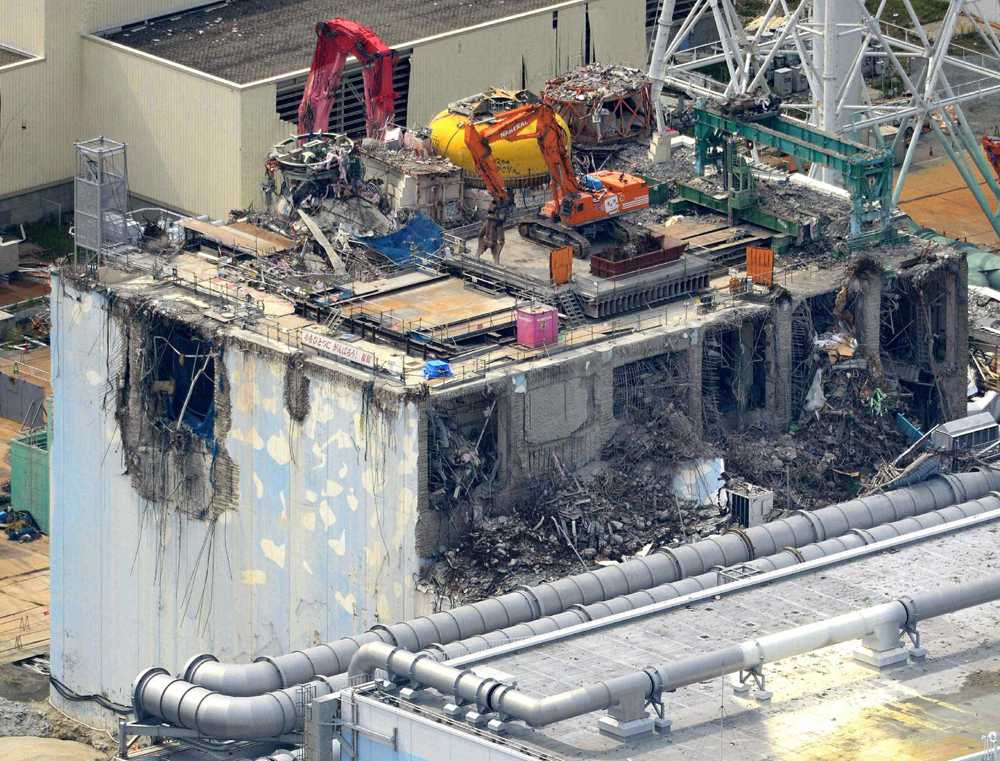A few years ago, I had
to make a decision to either restore an old school building in
Hong Kong for an environmental center - or demolish it. The long concrete
structure was built atop a garbage dump, and the final decision was
demolition due to uneven sinkage. Whenever heavy buildings are not foursquare
and level, massive internal stresses build up and rip the structure
apart.
In a recent helicopter photo of Reactor 4, seen from the east (ocean
side), there are similar signs of building sinkage. Along the middle-to-northeast
corner (right side), cross beams have fallen out, and at least two adjoining
pillars are of different height. The outer wall panels cracked and fell
off as a result. (Plus one can see clear through from the east
to northeast through a gaping hole.) Cross beams snap off due to the
displacement of pillars in opposite directions
What the combination indicates is that the footing of the structure
has cracked completely, with two-thirds of the building sinking at a
slight angle into the broken edge, while the smaller north side, relieved
of load, gradually rises with a series of popping noises. This springboard
effect is audible whenever a column lurches upward, like
the two pillars o n the right-hand side lifting the floor above it and
breaking out. (The pincher-clawed back-hoe is parked on a pad that spreads
the weight over the precarious structure.)
It is very probable that the reactor below is tilting as well. The concrete
footing for the structure is too thick to crack under weight alone or
even in a major quake, and so the cleavage was probably caused by the
corium searing along a line. Once burned, the concrete and rebar lose
their strength and can buckle and crack under seismic vibrations and
weight from above - especially if the ground is unstable. The March
11 quake probably caused liquefaction that opened an empty pocket below
the footing, and water seepage from the tsunami, rainstorms and coolant
leakage subsequently eroded the soil.
Since the spent fuel pools are on the south side, the strongest end
of the broken structure, one metal tank still appears to be intact,
judging from the corner that can be seen.
The twisted, overheated metal leaning out of the holes around the spent
fuel pool indicate the framework under the pool is wrecked. If the pools
are still level, it would be nothing short of miraculous. Odds are that
the pools are tilting, adding massive stress to the
whatever remains of the supporting frame.
The steel plate over the now-exposed floor/ceiling could be there to
prevent people from seeing that the spent fuel pool is tilting and lower
than its former position due to the bending of the metal frame below.
A tarp would have been melted by the heat released from the jostling
of the pool and loss of water in the two series of 2012 quakes that
further degraded the structure. Two sheets of steel plate could resist
temperature build-ups of up to about 1,000 C or around 2,000 F before
bending. Notably, open space is left on either side of the plates to
allow heat escape. The presence of the plates point to
flaring temperatures on occasion since the spent pool fires of
March 14 and 16, 2011.
The demolition work of June 26 had to be done to remove the weight of
the upper walls. This is consistent with what must be done when the
footing is cracked and lower floors are tilting inward, causing stress
buildup throughout the entire fabric of the structure.
That old school building rocked like a boat whenever a bus or truck
passed by on the adjoining road. For Fukushima workers, it would be
terrifying to be on top of a fractured structure that amplifies seismic
waves.
The ongoing self-destruction is inexorable and cannot be repaired or
reversed. When I checked the foundation of the old school structure,
the concrete was broken clean through in many places along roughly parallel
lines. Fixing a broken foundation is impossible, especially when it
is on uneven landfill, since the rubble below will firmly not hold up
an injection of concrete or jacking. Our team considered the possibility
of artificial support for that school building but quickly gave up the
idea as unfeasible. The far heavier Reactor 4 structure is following
the same pattern of step-by-step degradation, or phased collapse,
in which the stress factors are so complex that there is no way to predict
when or what part will be the next to go.
The rate of soil loss under the structure is still the determining factor
leading to a final collapse, and this problem of soil sinkage effects
the entire Fukushima No.1 plant site, which rests on landfill compromised
by quake-caused liquefaction, erosion by the tsunami, incessant
water leakage and melt-through of escaped nuclear fuel. Engineers therefore
had to push back the TEPCO plan to remove two fuel rods from Reactor
4 in this month of July. For the same reason of soil instability no
attempt has been made to set up a scaffolding or crane along the south
wall to lift rods into a casket.
Instead of an apocalyptic moment, as most observers had anticipated,
the ongoing degradation of Reactor 4 remains one of nerve-racking suspense,
of waiting for the next beam to drop.
Author: Yoichi Shimatsu is an environmental writer and consultant based
in Southeast Asia.
|
![]()
